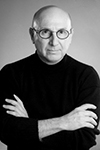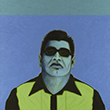Top Chicano artist to visit UHV class, give public presentation
Chicano artist César Martínez has shared his paintings, photos and prints of South Texas culture with the world.
On Tuesday, he will bring his work to Victoria as part of an inventive English class at the University of Houston-Victoria.
 |
| César Martínez |
Martínez will present a slideshow of his work at 11:30 a.m. in the Alcorn Auditorium of UHV University West, 3007 N. Ben Wilson St. The public is invited to attend. His free talk will be part of a UHV School of Arts & Sciences English composition class in which UHV writer in residence Dagoberto Gilb augments three faculty members in instruction for freshman students.
Martínez’s own work has progressed from his personal style of portraiture to incorporating computer graphics. No matter the medium, the work reflects the Laredo native’s own style.
“I am mostly known for my ‘pachuco’ paintings and my ‘Mestizo’ series, where I explore the southern Americas and the European connections using all kinds of symbolism,” he said. “But in all my work, I think it’s important that we not become hermetic. We don’t want the art to be just for Mexican-Americans.”
 |
| One of César A. Martínez’s paintings |
Martínez, who now resides in San Antonio, creates works that revolve around popular cultural icons, and his career has gone through phases using Aztec designs, religious subjects and the land of South Texas. After his service in the Army in the early 1970s, he was hailed for a 1975 work titled “Mona Lupe,” which mixed Leonardo da Vinci’s “Mona Lisa” with the Virgin de Guadalupe, a Mexican and Catholic religious icon.
But his portrait work has defined his career, bringing people he remembered from his childhood to his canvas with “barrio” (neighborhood) portraits, “pachucos” (Zoot suiters), “batos” (dudes) and their girlfriends. His portrait style, influenced by portrait photographers, features one-color backgrounds with the subjects looking straight ahead with deadpan expressions.
“I rarely put any discernible expression on my subjects,” he said. “I just have them looking straight out, or maybe with sunglasses on. That is a part of the mystique and attitude.”
“All of my work in one way or another has a connection with the culture that I grew up in, that is South Texas, in general, and the Chicano movement,” he said. “But I also try to cover the bigger-picture issues of where we come from and how we fit in. For some, there is a Mexico connection, for others, Spain or other parts of Europe.”
His style seeks to be direct but not overtly confrontational or political.
“I am political in my thinking and background, and I am a good citizen, and I vote intelligently,” he said.
However, Martínez said he sought a more confrontational tone with his “Bato” series, which featured “pachucos,” whose flamboyant suits and flashy cars were derided as un-American in the post-war 1950s.
“Ironically, when I started the ‘pachuco’ series, it was politicized internally,” he said. “Some older Mexican-American people asked, ‘Why don’t you paint something more appropriate?’ But I just let my art happen.”
Martínez said times have changed for his community since the politically charged 1970s.
“There are a ton of Mexican-American artists who aren’t necessarily into identity politics because it’s such a different context now,” he said. “Now we have established ourselves. For other generations, it’s different.”
Martínez stays busy reworking and reinterpreting his older works or exploring new ways to present them by testing different possibilities on the computer.
“My work has not moved. In a sense, I’m still working in traditional media,” he said. “But I’m using the computer a lot now, and there are ways to incorporate new technologies.”
Martínez also has become a favorite of comedian Cheech Marin, who is a serious art collector, among many others.
Author Dagoberto Gilb said Martínez’s work reflects the culture in a unique way.
“It is not often that any of us get to meet the legends of art history,” Gilb said. “For us, which means most of our UHV students, a class visit by a Mexican-American artist of his stature is like a visit by painter Paul Gauguin. He’s that big.”
The English composition class is an experimental class featuring Gilb and three other faculty members: Charles Alcorn, Diana López and Christine Granados.
“We at UHV are proud to support our faculty as they use their innovative and progressive vision to make these types of opportunities available to our students,” said Jeffrey Di Leo, dean of the UHV School of Arts & Sciences.
The University of Houston-Victoria, located in the heart of the Coastal Bend region since 1973 in Victoria, Texas, offers courses leading to more than 80 academic programs in the schools of Arts & Sciences; Business Administration; and Education, Health Professions & Human Development. UHV provides face-to-face classes at its Victoria campus, as well as an instructional site in Katy, Texas, and online classes that students can take from anywhere. UHV supports the American Association of State Colleges and Universities Opportunities for All initiative to increase awareness about state colleges and universities and the important role they have in providing a high-quality and accessible education to an increasingly diverse student population, as well as contributing to regional and state economic development.
Ken Cooke 361-570-4342




